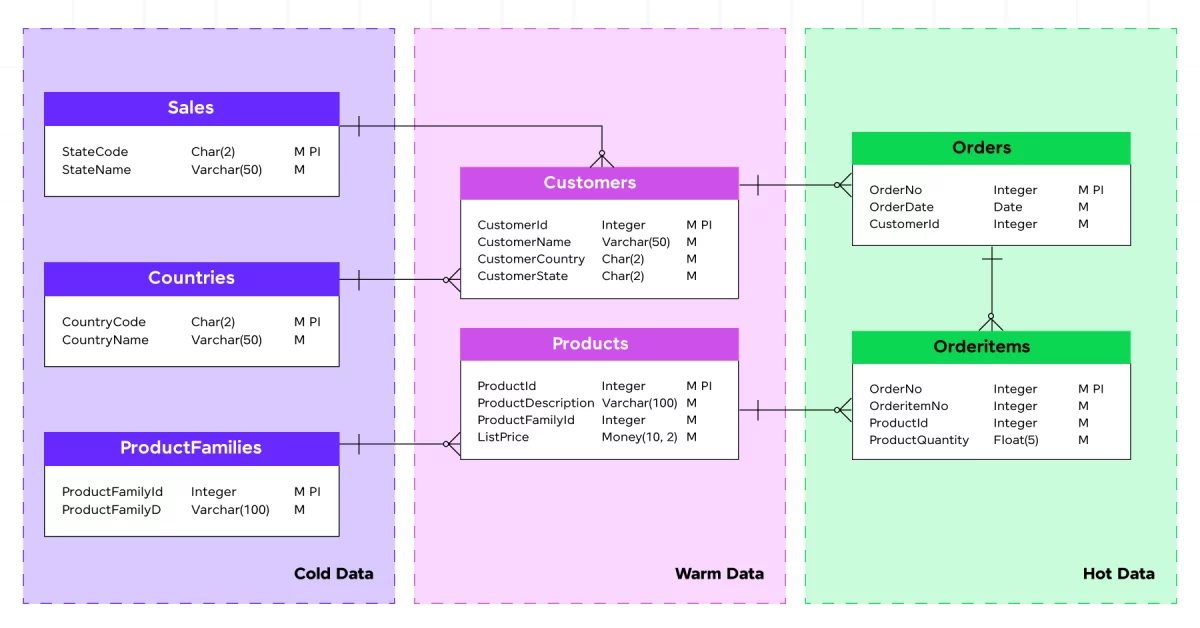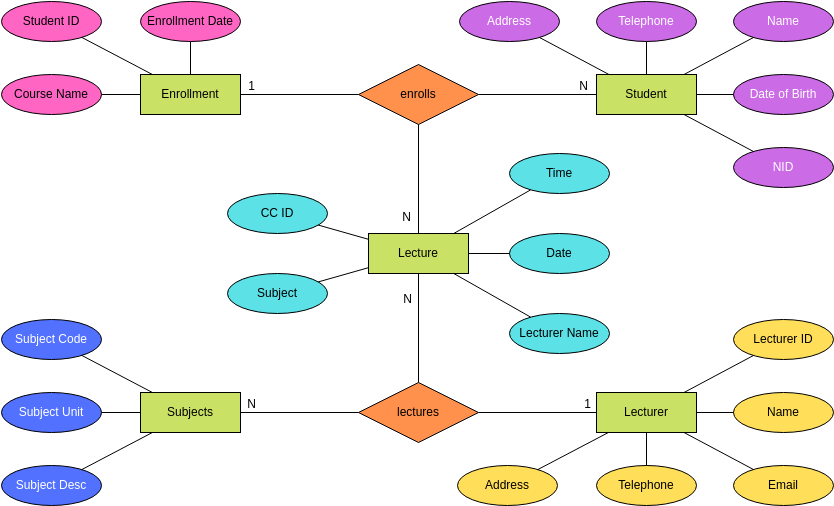Part 2: Database Design Principles
 CodeXoft KE
CodeXoft KE
1. The Art of Database Design: Entity-Relationship (ER) Diagrams
What is an ER Diagram?
An Entity-Relationship (ER) Diagram is a visual blueprint of a database’s structure. It defines entities (objects), their attributes (properties), and relationships between entities.
Key Components
Entities: Represent real-world objects (e.g.,
Student,Course,Professor).Attributes: Details describing entities (e.g.,
StudentID,CourseName).Relationships: How entities interact (e.g., a Student enrolls in a Course).
Cardinality: The number of instances one entity relates to another (e.g., one-to-many).
Example: University Database ER Diagram

Entities and Attributes:
Student:
StudentID(primary key),Name,Email.Course:
CourseID,Title,Credits.Professor:
ProfessorID,Name,Department.
Relationships:
A Student enrolls in multiple Courses (many-to-many).
A Professor teaches one or more Courses (one-to-many).
Cardinality Symbols:
One-to-Many (1:N ): A Professor teaches many Courses, but a Course has one Professor.
Many-to-Many (M:N ): Students can enroll in multiple Courses, and Courses have multiple Students.
2. Normalization: Eliminating Redundancy and Ensuring Data Integrity
Normalization is the process of organizing data to minimize redundancy and dependency. Let’s break it down with examples:
1NF (First Normal Form)
Rule: Eliminate repeating groups and ensure atomicity (each column holds a single value).
Example: Unnormalized Student Table
| StudentID | Name | CoursesEnrolled |
| 101 | Alice | Math, Physics |
| 102 | Bob | Chemistry |
Problem: The CoursesEnrolled column stores multiple values.
1NF Solution: Split into two tables.
Students Table
| StudentID | Name |
| 101 | Alice |
| 102 | Bob |
Enrollments Table
| StudentID | Course |
| 101 | Math |
| 101 | Physics |
| 102 | Chemistry |
2NF (Second Normal Form)
Rule: Remove partial dependencies (all non-key attributes depend on the entire primary key).
Example: Orders Table
| OrderID | ProductID | ProductName | Quantity | CustomerName |
| 001 | P1 | Laptop | 2 | Alice |
| 001 | P2 | Mouse | 3 | Alice |
Problem: CustomerName depends on OrderID, not the composite key (OrderID + ProductID).
2NF Solution: Split tables.
Orders Table
| OrderID | CustomerName |
| 001 | Alice |
OrderDetails Table
| OrderID | ProductID | ProductName | Quantity |
| 001 | P1 | Laptop | 2 |
| 001 | P2 | Mouse | 3 |
(Note: ProductName still violates 3NF—more on that next!)
3NF (Third Normal Form)
Rule: Eliminate transitive dependencies (non-key attributes depend only on the primary key).
Problem in OrderDetails: ProductName depends on ProductID, not OrderID.
3NF Solution: Split further.
Products Table
| ProductID | ProductName |
| P1 | Laptop |
| P2 | Mouse |
OrderDetails Table
| OrderID | ProductID | Quantity |
| 001 | P1 | 2 |
| 001 | P2 | 3 |
BCNF (Boyce-Codd Normal Form)
Rule: Every determinant must be a candidate key.
Example: Course Enrollment
| StudentID | Course | Professor |
| 101 | Math | Dr. Smith |
| 102 | Physics | Dr. Lee |
Problem: If a Professor teaches only one Course, Professor depends on Course (not the primary key StudentID + Course).
BCNF Solution: Split into two tables.
Courses Table
| Course | Professor |
| Math | Dr. Smith |
| Physics | Dr. Lee |
Enrollments Table
| StudentID | Course |
| 101 | Math |
| 102 | Physics |
3. From ER Diagrams to Relational Schemas
Let’s translate the University ER Diagram into actual SQL tables:
Step 1: Map Entities to Tables
Students Table
CREATE TABLE Students (
StudentID INT PRIMARY KEY,
Name VARCHAR(50),
Email VARCHAR(100) UNIQUE
);
Courses Table
CREATE TABLE Courses (
CourseID INT PRIMARY KEY,
Title VARCHAR(100),
Credits INT,
ProfessorID INT,
FOREIGN KEY (ProfessorID) REFERENCES Professors(ProfessorID)
);
Step 2: Handle Many-to-Many Relationships
Enrollments Table (Junction Table)
CREATE TABLE Enrollments (
StudentID INT,
CourseID INT,
PRIMARY KEY (StudentID, CourseID),
FOREIGN KEY (StudentID) REFERENCES Students(StudentID),
FOREIGN KEY (CourseID) REFERENCES Courses(CourseID)
);
4. Data Integrity and Constraints
Primary Keys
Uniquely identify each row:
CREATE TABLE Professors (
ProfessorID INT PRIMARY KEY,
Name VARCHAR(50),
Department VARCHAR(50)
);
Foreign Keys
Enforce relationships between tables:
CREATE TABLE Courses (
CourseID INT PRIMARY KEY,
Title VARCHAR(100),
ProfessorID INT,
FOREIGN KEY (ProfessorID) REFERENCES Professors(ProfessorID)
);
Unique Constraints
Prevent duplicate values in a column:
ALTER TABLE Students
ADD CONSTRAINT UniqueEmail UNIQUE (Email);
Check Constraints
Ensure data meets specific conditions:
ALTER TABLE Courses
ADD CONSTRAINT ValidCredits CHECK (Credits BETWEEN 1 AND 5);
5. Indexing 101: Speeding Up Queries
What is an Index?
An index is like a book’s index—it helps the database quickly locate data without scanning the entire table.
Example: Without vs. With Index
Slow Query (No Index)
SELECT * FROM Students WHERE LastName = 'Smith';
The database scans all rows.
Fast Query (With Index)
CREATE INDEX idx_lastname ON Students(LastName);
SELECT * FROM Students WHERE LastName = 'Smith';
The database uses the index to jump directly to ‘Smith’ entries.
When to Use Indexes
Columns frequently used in
WHERE,JOIN, orORDER BYclauses.Large tables (10,000+ rows).
When to Avoid Indexes
Small tables.
Columns with frequent write operations (indexes slow down inserts/updates).
Conclusion
Designing a robust database requires balancing structure (ER diagrams), efficiency (normalization), and performance (indexes). By mastering these principles, you’ll create databases that scale gracefully and handle real-world complexity.
Next Up: In Part 3: Mastering SQL, we’ll dive into writing advanced queries and optimizing them for speed!
FAQs
Q: How many normal forms are there?
A: There are 6+ normal forms, but 3NF or BCNF is sufficient for most applications.
Q: Can I over-normalize a database?
A: Yes! Over-normalization can lead to excessive joins, slowing down queries.
Q: Should every table have a primary key?
A: Ideally, yes. It ensures uniqueness and simplifies relationships.
Subscribe to my newsletter
Read articles from CodeXoft KE directly inside your inbox. Subscribe to the newsletter, and don't miss out.
Written by

CodeXoft KE
CodeXoft KE
Full-stack developer specializing in building exceptional digital experiences. Transforming ideas into elegant solutions through clean code and intuitive design.